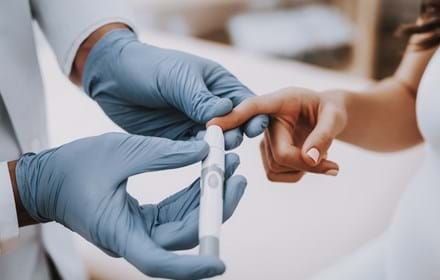
Smart insulin patch keeps blood sugar levels in check and replace injections
Daily insulin injections could be a thing of the past in the future of people with diabetes thanks to a new invention by researchers in the US.
The smart insulin patch, created by researchers at the University of North Carolina, can detect increases in blood sugar levels and secrete doses of insulin into the bloodstream whenever needed.
If the technology becomes widely available it could potentially change the daily routine of taking painful insulin injections for the millions of people with type 1 and advanced type 2 diabetes around the world.
The smart insulin patch could be placed anywhere on the body to detect increases in blood sugar and then secrete doses of insulin when needed (Courtesy of Zhen Gu, PhD)
The patch – a thin square about the same size as a penny – is covered with more than 100 tiny needles, each about the size of an eyelash. These “micro-needles” are packed with microscopic storage units for insulin and glucose-sensing enzymes (proteins) that can quickly release their cargo when blood sugar levels get too high.
The patch was featured in a recently published study in the Proceedings of the National Academy of Sciences. The study found that the new, painless patch could lower blood glucose in a mouse with type 1 diabetes for up to nine hours. More pre-clinical tests and subsequent clinical trials in humans will be required before the patch can be administered to patients, but researchers believe the new technology shows great promise.
Zhen Gu, PhD
Study Co-senior author Zhen Gu, PhD, a Professor in the Joint UNC/NC State Department of Biomedical Engineering, said: “We have designed a patch for diabetes that works fast, is easy to use, and is made from non-toxic, biocompatible materials. The whole system can be personalised to account for a diabetic’s weight and sensitivity to insulin, so we could make the smart patch even smarter.”
Diabetes affects more than 387 million people worldwide, and that number is expected to grow to 592 million by the year 2035. People with type 1 and advanced type 2 diabetes try to keep their blood sugar levels under control with regular finger pricks and repeated insulin injections, a process that can be painful and imprecise.
John Buse, MD, PhD, Co-senior author of the PNAS paper and the Director of the University of North Carolina Diabetes Care Center, said: “Injecting the wrong amount of medication can lead to significant complications like blindness and limb amputations, or even more disastrous consequences such as diabetic comas and death.”

An up-close fluorescent image of the microneedle patch with insulin tagged in green (Courtesy of Zhen Gu, PhD)
Researchers have tried to remove the potential for human error by creating “closed-loop systems” that directly connect the devices that track blood sugar and administer insulin. However, these approaches involve mechanical sensors and pumps, with needle-tipped catheters that have to be stuck under the skin and replaced every few days.
Instead of inventing another completely man-made system, Professor Gu and his colleagues chose to emulate the body’s natural insulin generators known as beta cells. These versatile cells act both as factories and warehouses, making and storing insulin in tiny sacs called vesicles.
They also behave like alarm call centres, sensing increases in blood sugar levels and signalling the release of insulin into the bloodstream.
Because mice are less sensitive to insulin than humans, the researchers think that the blood sugar-stabilising effects of the patch could last even longer when given to people.

A scanning electronic microscopy image of the smart insulin patch (Courtesy of Zhen Gu, PhD)
Professor Gu added that their eventual goal is to develop a smart insulin patch that people would only have to change every few days.
An NHS Behind the Headlines analysis of the insulin patch concluded: “This research is at an early stage and as yet, we don’t know how well it works in humans. For example, humans are much bigger than mice, and researchers will need to work out whether they can deliver enough insulin to regulate blood glucose levels in humans. They will also need to see how long such patches could regulate blood glucose levels for. Although people might prefer patches to injections, they might not want to change them frequently. Researchers will need to look at the long-term effects of wearing these patches in animals, to make sure they are safe and effective enough before testing them on humans.
“There is a lot of work going on in the field of diabetes research, looking at developing alternatives to insulin injections. This study has developed another possible approach, and research will likely continue on these patches and other alternatives.
“All in all, we wouldn’t expect to see these patches at your local chemist in the near future.”
Support DRWF by making a donation here
Find out more about DRWF-funded research here
Find out more about DRWF fundraising here
For latest update follow DRWF on Facebook, Instagram and Twitter
To receive the charity’s latest bulletins as they become available, please sign up here
Read DRWF diabetes information leaflets here
Join the Diabetes Wellness Network here
I would like to make a regular donation of
I would like to make a single donation of
There are lots of ways to raise money to support
people living with all forms of diabetes.
Bake, Swim, Cycle, Fly ... Do It For DRWF!
Fundraise with us
Recent News


